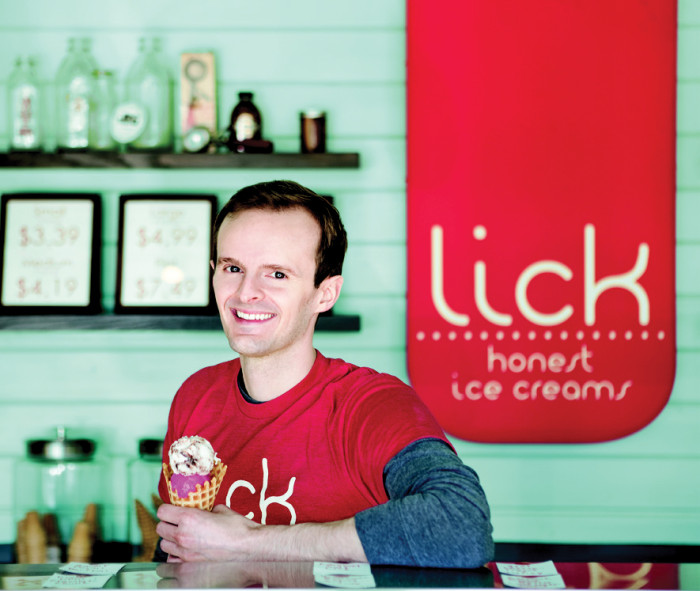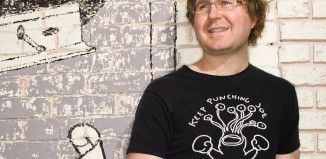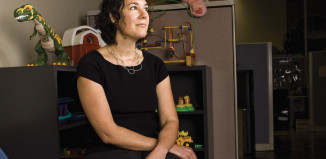In late October, after Lick Ice Creams had been open for a week, a woman who had just tried the shop’s cilantro lime ice cream characterized the flavor as “Austin during the summer at Barton Springs.” Another customer uttered a phrase that began with the word “holy” followed by a universally understood four-letter exclamation. Drawn in at first by the flavors, some of which are unorthodox—roasted beet and mint or goat cheese, honey and thyme—many patrons can’t believe that they’re also eating ice cream that’s sourced locally and free of artificial flavors.
The laudatory words have been music to the ears of Texas native Anthony Sobotik, whose devotion to local “honest” ice cream (light cream and fresh, organic produce with no additives, preservatives or high fructose corn syrup) has been the driving passion of his life for quite some time. The fact that the community is coming around to his way of thinking and getting inspired to view the beloved frozen dessert in a new way is the proverbial cherry on top.
 Sobotik opened Lick with his partner in life and business, Chad Palmatier. Sobotik’s lifelong interest in baking and cooking, along with his seven years of culinary experience, combined with Palmatier’s upbringing in the Amish region of Pennsylvania, where quaint small- town scoop shops and dairy farms dot the landscape, have informed the quality of their young business.
Sobotik opened Lick with his partner in life and business, Chad Palmatier. Sobotik’s lifelong interest in baking and cooking, along with his seven years of culinary experience, combined with Palmatier’s upbringing in the Amish region of Pennsylvania, where quaint small- town scoop shops and dairy farms dot the landscape, have informed the quality of their young business.
If you stop into Lick on any day of the week or night, you’ll find both of them cheerfully explaining the specifics of each flavor (the shop carries 20 flavors, with roughly ten permanent ones and the rest rotating, based on seasonality and whatever holiday is being celebrated) and its origin or chatting about potential new flavors as customers patiently wait—the line stretched out the door in mid-January.
All new entrepreneurs will pour their heart and soul into their venture. Working 70 to 90 hours per week is very typical for Sobotik and Palmatier. Spending brief moments away from the shop still means talking and thinking about it. The amount of labor involved and the inherent bumps in the road are not surprising. Several friends and former colleagues cited Sobotik’s driven, hardworking attitude and persistence as the keys to his success. Even so, the two clearly enjoy what they do and are grateful for the community’s wholehearted embrace of their newfangled concept.
Even though Sobotik easily could’ve chosen another city to launch his ice cream shop, no other city holds a more special place in his heart. This UT-Austin alum has a deep and abiding appreciation for this city. Whether he’s touting its entrepreneurial spirit or its role as a draw for the creative class, he is relentlessly upbeat about Austin.
Shannon Hrncir, a longtime friend from Sobotik’s hometown (Hallettsville) who lives in San Antonio, has frequent good-natured arguments with him about the nature of the two Texas cities and which has more to offer. “Austin is his home. He’s the biggest fan of it and all that it has to offer, from music to the lake, nightlife and education to, of course, the people.”
“Every day that I go in, when I unlock the door, I’m happy. Just getting there in the morning I’m always in a good mood,” said Sobotik. “I love when people come in and want to talk to me about their ideas.”
Sweet and Honest
Eating a spoonful of ice cream from Lick—whether it’s the caramelized carrots and tarragon or the dairy- free coconut, peanut butter and chocolate swirl—is a multisensory experience worth savoring. Texturally unique, jam-packed with flavor (Sobotik steeps all his herbs and veggies as opposed to using artificial additives), smooth and light, it’s not something you soon forget.
Not long after they met seven years ago in New York City, Sobotik and Palmatier took frequent trips via Amtrak to visit Palmatier’s family. On these trips to the Amish country of Pennsylvania, they sought out many old-school scoop shops that feature chrome fixtures and soda fountains of the type depicted in Norman Rockwell paintings. Intrigued by the concept of serv- ing fresh, homemade ice cream in an environment that evokes your grandmother’s kitchen, the couple went back often and kept exploring.
“These ice cream shops were perfect. The towns all have their own scoop shops where they locally source the ingredients,” said Sobotik. “Living up there, the sea- sons were really celebrated in the food and even in the ice cream.”
Whenever Sobotik came back to Austin to visit his friends from his undergraduate days at UT, he became more educated about local farms and all the new restaurants that were opening and sourcing locally. He couldn’t believe that no one had opened a scoop shop putting the same principles to work. When the timing was right to return to Austin—Palmatier said that his partner began extolling the Capital City’s many virtues shortly after they first started dating—they decided to move forward with a plan.
Sobotik has been making ice cream and trying out different flavors since he was a teenager. When he was 19, his mother bought an ice cream maker for him, and he would regale guests at summer pool parties with his frozen creations, utilizing such locally grown fruits as figs and peaches.
Catering in New York City and Columbus, Ohio, gave Sobotik the opportunity to write countless menus, learn the ins and outs of what flavors work with others, and hone his baking skills. He hopes to put these latter skills to use at Lick as well by introducing different cake inspired flavors and even ice cream sandwiches. Work- ing with Victoria Hink in Columbus fed his interest in entrepreneurialism. “Anthony and I always bounced ideas off each other about future business plans, recipes and food,” said Hink, owner of The Angry Baker.
For those unschooled in the finer points of ice cream, Sobotik is happy to talk (at length, which is part of his charm) about the details and why the sourcing matters so much. Many scoop shops use a mix for the dairy base; the producers of those mixes can’t guarantee specifically where it comes from or exactly which cows made the milk that went into it. In addition, the mixes tend to contain preservatives and everyone’s favorite unhealthy highly processed sweetener, high fructose corn syrup.
 Sobotik, whose grandparents had a farm in Hallettsville, Texas, wanted to know exactly where the milk and cream were coming from. He wanted to see the cows himself and he wanted to know what the cows were eat- ing—grass fed is key.
Sobotik, whose grandparents had a farm in Hallettsville, Texas, wanted to know exactly where the milk and cream were coming from. He wanted to see the cows himself and he wanted to know what the cows were eat- ing—grass fed is key.
He utilizes Texas Daily Harvest for his milk and cream and currently gets the majority of his produce from Johnson’s Backyard Garden, a certified organic vegetable farm located five miles east of Austin. That farm also supplies some of Whole Foods Market’s in- store dining venues. Round Rock Honey, Imperial Pure cane sugar from Sugarland, and such locally sourced spirits as Pecan Street Rum round out the ingredients of the delicious concoctions.
The ice cream benefits from the higher quality of milk: It’s nonhomogenized and low-temperature pasteurized. Nonhomogenized milk tends to have larger fat molecules, which makes it easier for the flavors of the fresh fruit and vegetables to bind to it. Light cream instead of heavy allows the flavors to come through more.
“People are like, ‘I can taste every single ingredient and the subtlety of each one,’” said Sobotik, who added that they hope to expand into wholesale at smaller local shops like Wheatsville, Fresh Plus, and Royal Blue Grocery. “It’s a win-win-win because you get to source local, not have things that are bad for you and enjoy delicious ice cream.”
Beyond offering ice cream that’s locally sourced and tastes unique, Lick maintains its green bona fides with biocompostable cups made from sugar cane fiber and spoons made from corn by-products.
Learning Curve
“I don’t know how he’s done it for three months. He’s done everything,” said Palmatier, who took a two- month hiatus from his full-time design job at H.E.B. on the first of this year so that he could spend more time at Lick. “Now, I’m there and I’m spinning. There is so much that can and needs to be done. It gives me a better appreciation of the demands of the business.”
The hardest part was finding the right location, according to the two, who signed a lease on their space in May of last year. Their main criteria included the size—they preferred something small and quaint— and being near a walkable neighborhood (Zilker, Bouldin and Barton Hills are nearby). Built in 1949 and adjacent to the Horseshoe Lounge, their light-filled scoop shop evokes an older, more innocent time. It’s usually filled with a diverse array of people.
Their biggest challenge is time: There are only so many hours in the day. However, in early February, Sobotik and Palmatier were in the process of interviewing potential part-time employees who were slated to start before March. Wholesale also goes hand in hand with freeing up more of Sobotik’s time for other aspects of the business.
Wholesale would require producing a larger amount of ice cream, which one might think is more time consuming. But using the large-scale pasteurizers at the dairy would produce 20 times the volume of dairy base in less than one-third the amount of time that it takes now. That leaves Sobotik with two additional days to formulate new flavors and think about other ways to expand the reach of business.
“The hardest part of working with your partner is that you have to not take things personally,” said Sobotik. “It’s a positive and a negative all rolled into one: When we were coming up with the logo, I felt comfortable being completely honest with him. Also, it’s a negative because sometimes when you’re working together, you can comment on something and there’s a misunderstanding.”
Even when they’re at the shop all the time, they still have to create ways to have time as a couple outside of work, which can be a challenge. For Christmas, Palmatier, the more laid-back of the two men, went home to visit his family in Pennsylvania. When they did have dinner together to celebrate the holiday and left the shop for two hours, they were still talking about—you guessed it—Lick.
Palmatier said that creating more time to unwind and exercise is also key. “You’re with this person every moment of every day and you don’t have separate lives anymore, “ he said. “When it’s good, it’s great. We’re working on having more ‘us’ time.”
Trying to keep up with Sobotik is next to impossible. (Even this reporter, familiar with the frenetic pace of living eight years in the Big Apple, had trouble.) On most days, he arrives at the shop by 8 a.m. and is making ice cream, filling pints, churning, and making cones for the next few hours. On what he called “production days,” he’s making the other ingredients from scratch: roast- ing and pureeing the vegetables and washing and steeping the herbs, for instance. Over the weekend, it’s the farmer’s market and everything else.
Amidst all of that, he’s politely and cheerfully explaining the intricacies of making the ice cream, the sourcing, and the flavor profiles to any and all customers who walk through the shop’s glass-fronted entrance on South Lamar. Not only is Sobotik moving at a nonstop, coffee- fueled pace—he’s also very loquacious when it comes to anything about food and ice cream.
 Still, having his partner at the shop full-time has been beneficial in at least two ways: It gives Palmatier a renewed understanding of the nuts and bolts of the business, and it forces the two to commit to a more reasonable schedule. Palmatier, with 15 years of commercial design experience under his belt at companies such as Kenneth Cole and Victoria’s Secret, took great pride in designing Lick’s environment and branding package. Since opening the shop, he has been offered some freelance design projects as well.
Still, having his partner at the shop full-time has been beneficial in at least two ways: It gives Palmatier a renewed understanding of the nuts and bolts of the business, and it forces the two to commit to a more reasonable schedule. Palmatier, with 15 years of commercial design experience under his belt at companies such as Kenneth Cole and Victoria’s Secret, took great pride in designing Lick’s environment and branding package. Since opening the shop, he has been offered some freelance design projects as well.
“He’s doing some design work on the side, and he’s realizing that everything has to get done in the morn- ing before the shop is opened,” he continued. “Since our volume has picked up, thank God that he’s here, because I have to make so much more ice cream than before. I like him being there and I like that he can do more work with the business that he wants to do, such as coming up with marketing ideas. I feel like there’s more balance, because I’m comparing it to the last three months.” A one hundred-hour workweek last fall, at the far end of the spectrum, was unsustainable, Sobotik added.
In a Good Place
A proud Texan through and through, Sobotik is nothing if not optimistic about the Lone Star State’s capital, frequently driving around to scout potential sites for future branches of Lick and happily engaging in some civic cheerleading with locals and visitors who come into the scoop shop.
He described his time at UT, where he majored in journalism with a history concentration and took part in the school’s U-Teach Program, in glowing terms.
He became an orientation advisor, forged a number of friendships—that have lasted to this day—and worked for the Texas Union.
It’s also when he came out at the age of 20. All his friends were supportive and the city itself was a great place for that experience, he recalled. However, his Southern Baptist mother had a hard time with it at first, worrying about what other people would say. Although that’s a fairly typical parental reaction, Sobotik said that he was always confident that she would come around.
“We’ve gotten to a place where Chad’s part of the family,” he said. “We’re in a good place.”
Family has also influenced Sobotik’s business and life in other ways. His grandfather raised bees and his grandmother on his dad’s side worked off the land, picking cotton. Both of his grandmothers were extremely hard- working and led lives that were difficult and full of hardship. Even so, they carried themselves with grace and strong faith in the goodness of others.
“Not that they don’t have down times, but they’re both very positive people,” said Sobotik. When he was younger, they took meals to people over the holidays who were homebound with illness; that giving-back ethos stuck with him. “Neither one of them is attached to things, and they’re both quite generous.”
Once the business settles into a stable groove, Sobotik said that he’d like to get involved with local libraries and host ice cream socials that are tied to summer reading programs. Another group he’d love to form a partnership with is Out Youth, which has been providing programming and a safe space for the city’s LGBT youth for more than two decades.
“I’d like to have kids come through and learn how to make ice cream and also to see where things come from,” he said. “So, to have field trips to the farms so they can understand where it all comes from. Kids don’t grow up the way that I grew up, being from a small town, when you see the livestock and you go through the garden with your grandparents.”
Instilling those values in children at a young age is helping to educate the next generation of more eco- conscious consumers. It creates less waste, as well, once people realize much work goes into growing each vegetable, he continued. “They only buy what they’re going to consume.”
In the midst of a long day, Palmatier was still smiling about this newfound adventure. “The most rewarding part is having happy customers.”
Sobotik’s life is pretty much 24/7 ice cream at this point, but he’s not complaining.
“Ice cream is such a blank slate. I can take all the things I love—cooking, baking, everything—and put them into ice cream,” he said. “That’s why ice cream is perfect. It’s fun to take something that everyone loves and then make them think about it in a different way. People love ice cream!”




































